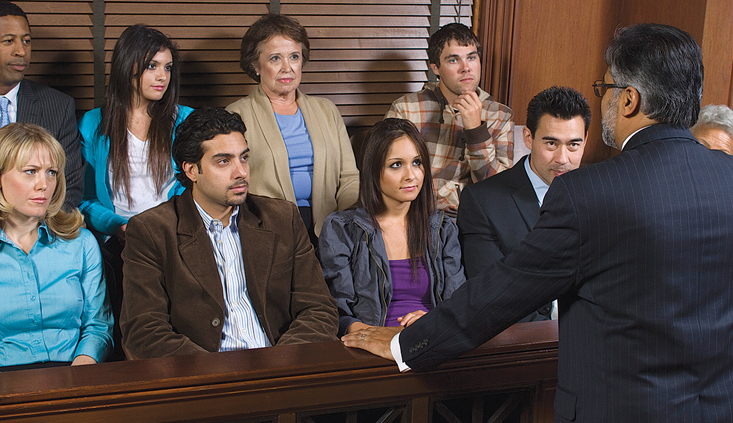Duty calls
Jury service – a learning opportunity
I unlocked the front door. Lying in the mail pile on the floor – an official envelope. A real one, not one of the fake “official business” envelopes. A jury summons. Most people grumble when they receive a summons – trial lawyers included. I’m no different. Taking time from work – significant time – can cause consternation. How long will it last? What happens to my cases while I’m gone? But we who live by the jury system cannot shirk jury duty without the taint of hypocrisy.
There’s a flipside for some – an overwhelming desire to serve. Not for duty alone. But from a fascination perspective. Focus groups are one thing. Nothing compares to seeing a real jury deliberate. And there’s only one way to do that (legally, Kevin Lomax). That’s by being a juror.
Most lawyers get struck. (Remember though – despite your plaintiff background you can always be fair – make that civil defense lawyer use a peremptory). Imagine my surprise when I was sworn in as a juror on a felony murder trial. This despite knowing some of the experts.
Jurors don’t remember everything
We triple-think every courtroom maneuver. We know the jury’s limits. Some learn best from seeing, others by hearing, others by touching. We try to provide evidence for all three – exhibits, testimony, physical models. Retention increases dramatically when you provide visual, audible, and kinesthetic evidence. Despite this, jurors don’t retain every tasty evidence treat placed before them. They don’t want to be there. Consider yourself an elementary school teacher. Your audience has a short attention span, and they don’t want to be there. If you don’t entertain and shift the medium, they will drift.
You must arm them with the evidence and then remind them about how to locate it in closing. Tell them to ask for readbacks from the court reporter if in doubt. Jurors hesitate to ask. They doubly hesitate after their first request – when it takes 45 minutes before the lawyers and judge agree on the reading and the reporter pulls it up. Reinforce that it is not just their right, it is their job, to make sure they have the correct understanding of the evidence.
Physical evidence versus eyewitness testimony
Anyone who has spent time with an accident reconstructionist (or the witness jury instruction) knows that eyewitness testimony is unreliable. We approach cases with this bias. Jurors don’t. Nor do they focus on the witness instruction. They remember the instruction that says evidence will come in a variety of fashions and to give it all equal weight. When the car’s skid marks demonstrate a car was going 40 miles an hour and a witness says it was going 10, some jurors may believe the witness despite the physical evidence. This is important to consider when evaluating your case. Jurors may not weight the evidence the same way.
Reading jurors is like reading tea leaves
There are some exceptions. The person who scowls, folds his arms, and turns his body away every time you stand up might not like you. But the friendly smiling person does not guarantee a win – that juror might just be polite. The juror sitting next to me scribbled madly at points. The lawyers noticed. So did I. I looked over at her pad – sheer scribble. Random ink. During a break I asked her why her scribbles were so animated. Her response? “Keeps them guessing, doesn’t it?”
Dramatic subtlety
The trial I sat on involved a stolen car and a barreling full police chase, “Streets of San Francisco” style, through the Excelsior. It came over a hill and crushed an unfortunate contractor who was loading his truck. The murder. We knew from the description that the death was gruesome. The prosecutor never showed the scene photos though. During closing, he said, “If you have any doubt about the horrific nature of the defendants’ actions, look at Exhibit 32. This is it (he held it up). It will be in the jury room with you. It contains the photos of what happened to Mr. X. I haven’t shown them because they are difficult to look at. But they explain why we are asking for a guilty verdict.” (Note that I’m paraphrasing – it has been several years and I was a juror, thus my memory is not photographic.)
The jury initially selected a foreperson. Next? They grabbed Exhibit 32. It was every bit as awful – read torso 20 feet from the pelvis, connected by intestines – as one might expect.
Convictions
We convicted. There was a conflict between the physical evidence and eyewitness testimony that takes too long to explain − a central reason for the trial. Ultimately, 12 of us found the defendants’ actions, during the course of a robbery and in a stolen car, killed a man. A difficult decision. But that is the nature of jury service – tremen -dous power over a person’s future. Something we remind our jurors about in every trial.
Miles B. Cooper

Miles B. Cooper is a partner at Coopers LLP, where they help the seriously injured, people grieving the loss of loved ones, preventable disaster victims, and all bicyclists. Miles also consults on trial matters and associates in as trial counsel. He has served as lead counsel, co-counsel, second seat, and schlepper over his career, and is an American Board of Trial Advocates member.
Copyright ©
2025
by the author.
For reprint permission, contact the publisher: Advocate Magazine

